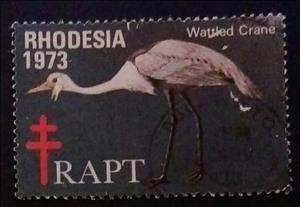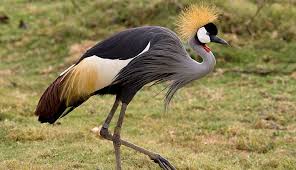Stamp: RAPT Wetland Crane (Cinderellas 1973)
RAPT Wetland Crane (Cinderellas 1973)
01 January (Cinderellas ) within release Rhodesia goes into circulation Stamp RAPT Wetland Crane face value None No Face Value
| Stamp RAPT Wetland Crane in catalogues | |
|---|---|
| Colnect codes: | Col: RH 1973-02 |
Stamp is square format.
Rhodesia Association for Prevention of TuberculosisAlso in the issue Rhodesia:
- Stamp - RAPT Clawless Otter face value None;
- Stamp - RAPT Wetland Crane face value None;
- Stamp - RAPT Orange Finned Minnow face value None;
- Stamp - RAPT Flamingos face value None;
- Stamp - RAPT Crocodile face value None;
- Stamp - RAPT Red-breasted Bream face value None;
|
Data entry completed
53%
|
|
|---|---|
| Stamp RAPT Wetland Crane in digits | |
| Country: | Cinderellas |
| Date: | 1973-01-01 |
| Perforation: | 14½ |
| Emission: | Cinderella |
| Format: | Stamp |
| Face Value: | None No Face Value |
Stamp RAPT Wetland Crane it reflects the thematic directions:
Animals are multicellular, eukaryotic organisms of the kingdom Animalia (also called Metazoa). All animals are motile, meaning they can move spontaneously and independently, at some point in their lives. Their body plan eventually becomes fixed as they develop, although some undergo a process of metamorphosis later on in their lives. All animals are heterotrophs: they must ingest other organisms or their products for sustenance.
Birds (Aves), a subgroup of Reptiles, are the last living examples of Dinosaurs. They are a group of endothermic vertebrates, characterised by feathers, toothless beaked jaws, the laying of hard-shelled eggs, a high metabolic rate, a four-chambered heart, and a strong yet lightweight skeleton. Birds live worldwide and range in size from the 5 cm (2 in) bee hummingbird to the 2.75 m (9 ft) ostrich. They rank as the class of tetrapods with the most living species, at approximately ten thousand, with more than half of these being passerines, sometimes known as perching birds. Birds are the closest living relatives of crocodilians.
help, especially in the form of money, given freely to people who are in need, for example because they are ill, poor, or have no home, and organizations that provide this help: She does a lot of work for charity.
Cranes are a type of large bird with long legs and necks in the biological family Gruidae of the order Gruiformes. The family has 15 species placed in four genera which are Antigone, Balearica, Leucogeranus, and Grus. They are large birds with long necks and legs, a tapering form, and long secondary feathers on the wing that project over the tail. Most species have muted gray or white plumages, marked with black, and red bare patches on the face, but the crowned cranes of the genus Balearica have vibrantly-coloured wings and golden "crowns" of feathers. Cranes fly with their necks extended outwards instead of bent into an S-shape and their long legs outstretched.




